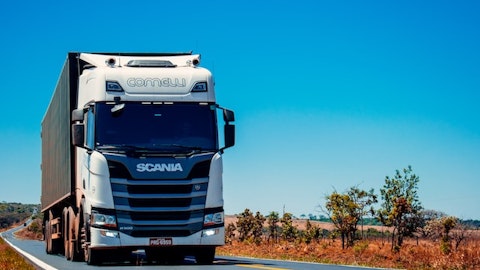John Chappell: Jim, as it relates to intermodal margin, obviously, there’s a lot of optimism about getting volume back on the different networks. But the margin has obviously taken a pretty significant step back over the last 12 months. Is this strictly a function of the volume will drive the turns, will drive productivity, will drive margin improvement? Or are there other things that you can actually do internally to better the cost structure, provide more operating leverage, so you can even have some volume improvement — I’m sorry, some margin improvement before you really get a true volume inflection?
Jim Filter : Yes. So obviously, during the quarter, there were some additional containers that were put on stack. So there was some additional costs that was absorbed. There’s also opportunity just running a more efficient network. So it’s not just getting volume, but getting the right volume that reduces our empty repositioning costs as well as our driver productivity. So those are all the focus areas to be able to improve margin.
Operator: Your next question comes from the line of Jack Atkins from Stephens.
Jack Atkins: So I guess, I’m going to go back to the guidance for a second because I think what folks are confused about is when you kind of adjust for the taxes and the insurance headwind in the fourth quarter, I mean your kind of exit rate is about $0.60, $0.65, something like that for kind of a full year exit annualized in the fourth quarter, and you’re guiding to $1.15 to $1.30. So I guess we’re just trying — what I’m trying to really get my arms around is what specifically are you assuming for a cycle turn in the second half of the year to kind of get to the bottom end of this guidance range? Because it would seem like there’s a pretty substantial improvement in underlying business trends there. So kind of help us think through that because we all hope something is going to happen, but it seems like you’re expecting it to happen.
Mark Rourke: Well. Jack, and I’d like to address that in a couple of fronts. First, we focused in on our company-specific objectives and the annualization of all the good work we’ve been doing in dedicated, both acquisitively and organically. And the prospects that we anticipate, many of which we have visibility to from contract closures and start-ups. So we are leaning into key strategic initiatives that allow us to continue to improve our overall business results in that. And our truck business dramatically focuses on dedicated and I feel really good about where we’re positioned there. Secondly, we do believe that based upon our alignment with our customers, what they look to accomplish relative to intermodal growth and how that fits into what their strategies are, that we are well-positioned, and we’re leaning in hard to change some of the trajectory we’ve experienced in that business in 2023 to include the really unique opportunities that are emerging in Mexico.
So that’s two. Third, as you would expect, we’ve been leaning, really, since the middle of 2022 into a cost structure and how we can become more efficient. You saw in our results sequentially, the third or the fourth quarter that asset productivity improved without demand improving in a very material way. So again, those initiatives that we are leaning into to improve asset turns across everything that we do, across our portfolio is things that we think and expect to improve results. But clearly, we believe we’re also very long into the cycle. Our internal metrics that we look at, which is a combination of company-specific correlation factors and certain outside elements of data that also, over time, have correlated to cycles, where we — at the end of this month, we’ll surpass 600 days, as I mentioned in my opening comments, which is historically very long in the cycle.
There’s some macroeconomic, whether it’s rate condition, inflation, consumer confidence, we do believe things will turn to an extent, and we’ll get back into some level of restocking that’s been stubbornly slow, and capacity continues in a slow and steady pace to exit the marketplace. And that doesn’t include a catalyst that, over time, have occurred that can accelerate that. So we’re taking those company-specific things. We’re taking a slow and steady capacity exit, a restocking again, a slow and steady restocking that will continue, that we believe has the highest probability to improve throughout the year, and that’s what we put into that context. That’s what we put into that guidance range.
Jack Atkins: And then I guess maybe for my follow-up, it’s really on insurance. I mean, I think almost everyone that’s reported so far during this earnings season has had some sort of insurance, either accrual, true-up. It’s been a kind of key topic on all these calls. As you sort of are thinking about this moving forward, could you talk about any sort of inflation that you’re expecting in your premium costs in 2024? But — or would you just expect insurance as a percentage of revenue moving forward to just be a higher number? It just feels like, structurally, the market is just hard on some.
Mark Rourke: Yes. I think the insurance markets, whether you’re talking trucking or really any other portion of the economy, is under pressure from a premium standpoint, and certainly, we expect and we feel that. I think what’s really important when we look at Schneider specifically, we had a 16 consecutive quarter streak where we did not have these type of adjustments. So we take — first of all, safety from a training and technology, what we do every day from the core value of the company very seriously, and it’s reflected in our results, and you see it in the incident exposure reduction that I shared with you, 19% over the last couple of years. So all of that is incredibly important, and it’s also incredibly important to be realistic about when you have a risk exposure that you have evaluated it correctly and you deal with it in a way that it doesn’t escalate.
Unfortunately, that 16 consecutive quarter streak snapped on us this year with two primarily around two incidents. And so, I don’t accept the fact that it’s a continuous issue, but they do happen, and this was our time for them to happen. So Jack, so yes, I think the insurance premium side of that is an external factor that we’re going to have to deal with as everybody will but we are leaning in really hard because nothing we do is worth hurting ourselves or others, and it — for me, it’s every part of our organization.
Operator: Your next question comes from the line of Tom Wadewitz from UBS.
Tom Wadewitz: So I wanted to ask a little bit about the intermodal margin. I think there’s been this kind of anticipated help on purchase transportation, it seems like it just hasn’t been visible yet in terms of helping on the margin side. Is that something that you think will continue to be elusive? Or is it reasonable to think that if you look at whether it’s 1Q or 2Q, that you would see sequential improvement in that intermodal margin supported by that kind of lagged reduction in purchase transportation?
Jim Filter : Yes, Tom. So yes, we still have our long-term margin targets out there, and we still believe that those are the right target margins for all three of our segments, and believe there will be a point that we get to that spot. I couldn’t give you a timing of which quarter we get back to that, but we do anticipate that we’ll get back to those long-term margin targets.




